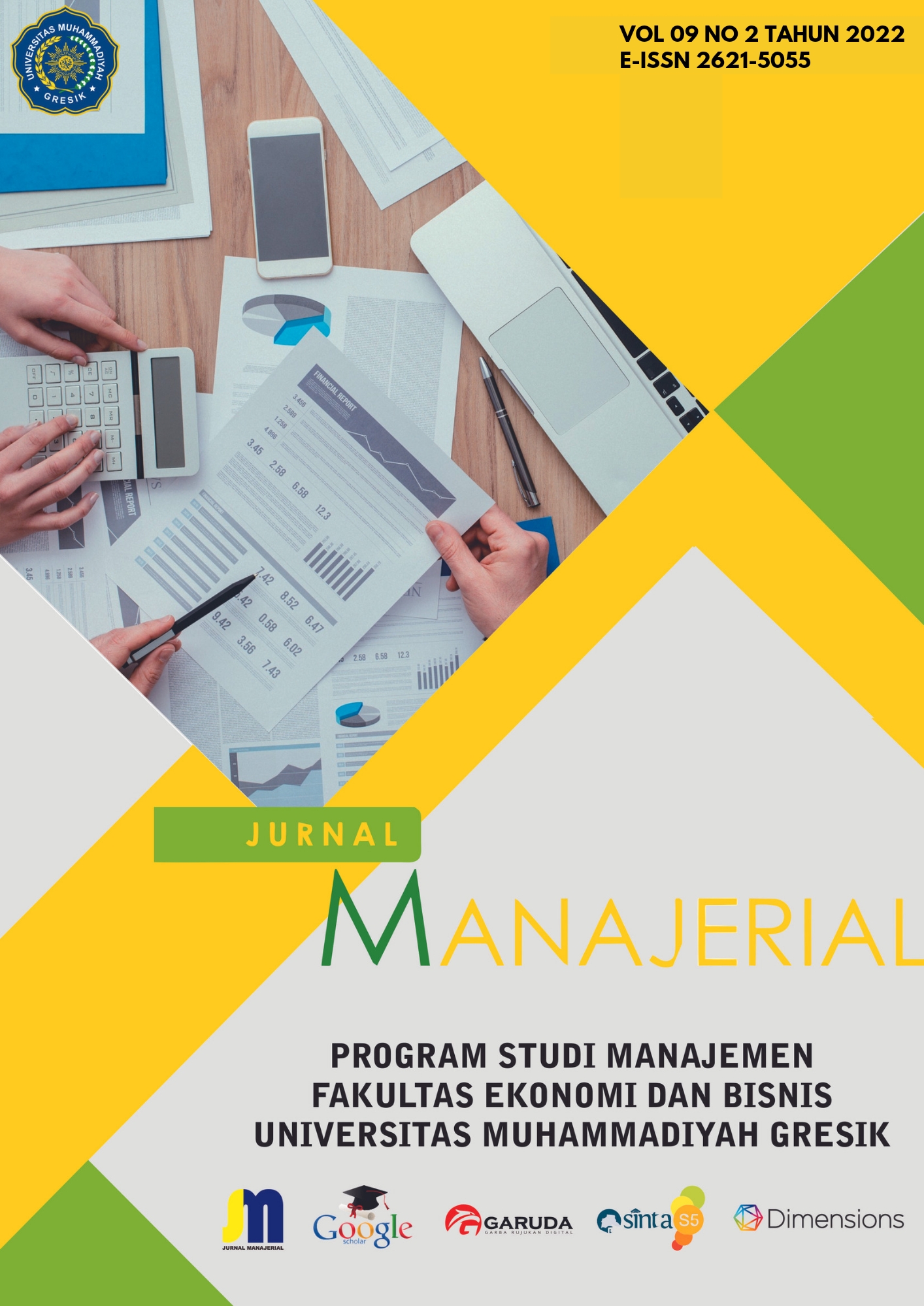Memahami Mental Kerja Karyawan Melalui Analisa Worklife Balance Pada Turnover Intention Di Perrguruan Tinggi Swasta Di Bawah BUMN Gresik
DOI:
https://doi.org/10.30587/jurnalmanajerial.v9i02.3932Keywords:
Work, Life, Balance, Stress, Turnover, IntentionAbstract
Background – Mental health is influenced by events in life that leave a great impact on personality and a person, while mental health is related to Work-life Balance and stress management. Employees who fail to achieve Work-life Balance will have high levels of stress both at work and outside of work, which can have negative consequences, especially Turnover intention. Aim – analyze the direct effect of Work-life Balance on the Turnover intention of higher education employees under BUMN in Gresik and the indirect effect of Work-life Balance through work stress. Design / methodology / approach – Quantitative research using path analysis, with a sample of 89 employees of private universities under BUMN in Gresik. Result and discussion – Work-life Balance has a significant value of 0.008 <0.05 and t-count -2.695 > t-table -1.987, so that Work-life Balance has a direct negative effect on employee Turnover intention. Job stress has a significant value of 0.530 > 0.05 and t-count 0.631 < t-table 1.987, so it has no direct effect on Turnover intention. Work-life Balance which has a significant value of 0.05 <0.05 and t-count -1.989> t-table 1.987, so it has a direct negative effect on employee work stress. Finally, Work-life Balance has a significant value of 0.53 > 0.05 and t-count -0.231 < t-table 1.987, so it does not have an indirect effect on Turnover intention through the work stress variable as an employee mediation variable. Conclusion - According to the findings from this study, the Turnover rate is influenced by work life balance directly or by mediating work stress. Research implication – Universities need to improve or be able to better balance the personal lives of employees with their personal lives, because it is found that the employee Turnover rate will decrease if employees have a good and balanced Work-life Balance. Limitations – Research related to mental through work life balance, work stress in influencing Turnover intention is limited to employees of private universities under BUMN in Gresik.
References
Clark SC. 2000. Work/Family Border Theory: A New Theory of Work/Family
Denizia Rizky dan Tri Wulinda Afrianty “Pengaruh Beban Kerja Terhadap Stres Kerja Dengan Work-life balance Sebagi Variabel Intervening”. Jurnal Adminitrasi Bisnis (JAB), Vol. 61 No. 4 – 2018
Echolis, J. M dan Hassan S. (2000). Kamus inggris-indonesia. Jakarta : Gramedia.
Engagement and Turnover intention”.The South East Asian Journal of Management Vol. 13 No. 1, 2019 pp. 106-118
Faisal NoorHidayat, Sri Suwarsi dan Dudung Abdurrahman “Pengaruh Work Life Balance terhadap Stres Kerja dan Kinerja Karyawan pada PT. Pln (Persero) P2b Apb Jabar”.Volume 3, No.2, Tahun 2017
Fisher GG, Smith CS, Bulger CA. 2009. Beyond work and family a measure of work/non work interference and enhancement. Journal of Occupational Health Psychology. http://psycnet.apa.org
Gibson I.D. 1996. Stres dan Kepuasan Kerja. Jakarta (ID): Pustaka Binaman Pressindo.
Gitosudarmo I, Sudita N. 2000. Perilaku Keorganisasian. Yogyakarta (ID): BPFE
Greenhaus JH, Beutell NJ. 1985. Sources of conflict between work and family roles. The Academy of Management Review.
Greenhaus JH, Collins KM, Shaw JD. 2003. The relation between work-family balance and quality of life. Journal of Vocational Behavior http://sciencedirect.com
Handoko T.H. 2003. Manajemen Personalia dan SumberDaya Manusia.Yogyakarta (ID): BPFE.Hudson Highland Group, Inc.
Hudson. 2005. The case for work/life balance. Series 20:20. Adelaide (AU):
Igbaria, M dan Greenhaus, J. 1992. Determinants of MIS Employees Turnover intentions : A Structural Equation Model. Communication of the ACM.
Intan Yogi Pratiwi dan I Komang Ardana “Pengaruh Stes kerja dan Komitmen organisasi Terhadap Intention to Quit Karyawan pada PT. BPR Tirsh Batubulan” E-Jurnal manajemen Unud, Vol.4 No. 7-2015
Kalliath T, Brough P. 2008. Work-life balance: A review of the meaning of the balance construct. Journal of Management and Organizationhttp://www.emeraldinsight.com
Kaushalya, RKN and Perera, GDN “The Impact Of Work-life balance On Employee Turnover intention In Selected Private Banks in Colombo District, Sri Langka”.Human Resource Management Journal, Vol. 6 No. 1 – 2018
Marjan Fayyazi, Farshad Aslani “The impact of work-life balance on employees’ job satisfaction and turnover intention; the moderating role of continuance commitment”. International Letters of Social and Humanistic Sciences Vol. 51, pp 33-41
Muhammad Andi Prayoi, Murviana Koto dan Muhammad Arif (2019) “Kepuasan kerja sebagai variabel intervening pada pengaruh Work-life balance dan Stres kerja terhadap Turnover intention”. Jurnal Ilmiah Manajemen dan Bisnis Vol 20 No.1-2019
Muhammad hafid dan Arif pratono (2017) ‘Pengaruh Work-life balance terhadap Turnover intention’(Studi pada karyawan divisi food & baverage Hotel Indonesia kempinski Jakarta). Jurnal Management Research, Vol XIV, No 3-2017
Nafiudin “Analisis Turnover intention Karyawan Generasi Y di Provinsi Banten Serta Faktor Yang Mempengaryhinya”. Jurnal Penelitian Ekonomi dan Bisnis, Vol.2 No. 1-2017
Ni Ketut Septiari dan I Komang Ardana “Pengaruh Job Insecurity dan Stres Kerja terhadap Turnover intention Karyawan pada Hotel Asana Agung Putra Bali”. E-Jurnal manajemen Unud, Vol. 5 No. 10-2016
Nor Siah Jaharuddin and Liyana Nadia Zainol “The Impact of Work-Life Balance on Job
Parkes LP, Langford PH. 2008. Work–life balance or work–life alignment?. Journal of Management & Organizationhttps://www.cambridge.org
Rashid Saeed, Rab Nawaz Lodhi, Kalil Ahmed DKK” Work-life balance And Stres Whit The Rate Of The Employees”.World Applied Sciences Journal 26 (6):834-839, 2013
Robbins, S. P. (2017). Organizational behavior: Concepts, controversies, and applications nineth edition. USA: Prenctice Hall Inc.
Selye, H. 1976. The Stres of Life, Stres dalam hidup kita. Alih Bahasa. Jakarta (ID): Departemen Kesehatan Republik Indonesia.
Shagvaliyeva S, Yazdanifard R. 2014. Impact of flexible working hours on work-life balance. American Journal of Industrial and Business Management
Sturges J, Guest D. 2004. Working to live or living to work? Work/life balance early in the career. Human Resource Management Journal
Taghrid S. Suifan, Ayman Bahjat Abdallah and Hannah Diab “The Influence of Work Life Balance on Turnover intention in Private Hospitals: The Mediating Role of Work Life Conflict”. European Journal of Business and Management Vol.8, No.20, 2016
Vanderpool C, Way SA. 2013. Investigating work-family balance, job anxiety and turnover intention as predictors of health care and senior services customer contact employee voluntary turnover. Focus on Human Resources http://www.emeraldinsight.com
Zeffane, R. (1994). Understanding employee turnover: the need for a contingency approach. International Journal of Manpower, 15 (9), 1-14.






























 P-ISSN: 2354-8592 __ E-ISSN: 2621-5055
P-ISSN: 2354-8592 __ E-ISSN: 2621-5055 
